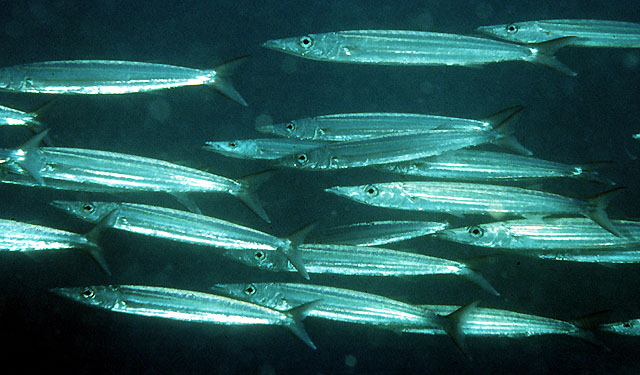| Sphyraenidae (Barracudas) |
| 100 cm TL (male/unsexed) |
|
pelagic-neritic; marine |
| Indo-Pacific: southern coast of Australia. |
|
Dorsal spines (total): 6-6; Dorsal soft rays (total): 9-9; Anal spines: 2-2; Anal soft rays: 8-8. This species is distinguished by the following set of characters: first gill arch with one gill raker; pelvic-fin insertion is located slightly before vertical through first dorsal-fin origin; pored lateral-line scales 120-138 (modally 127), total lateral-line scales 129-146 (134); scales above lateral line 9-11 (10) and below, 11-13 (12); snout is comparatively short, its length 12.2-14.0 (mean 13.2) % SL; upper jaw short, with posterior tip not reaching to below anterior nostril, its length 9.2-10.7 (10.0) % SL; eye small, orbit diameter 3.4-4.5 (4.0) % SL and depth, 3.3-4.2 (3.7) % SL; anal-fin base long, its length 7.6-9.2 (8.5) % SL; last dorsal- and anal-fin ray lengths are 3.6-4.5 (4.0) % SL and 3.3-4.3 (3.9) % SL, respectively; anus is comparatively close to anal-fin origin, its anterior and posterior margins to anal-fin origin 5.8-8.0 (6.9) % HL and 3.1-5.1 (4.0) % HL, respectively; the head sensory canal pores on suborbital area are finely branched, their lowermost parts very close to lacrimal bone margin, large smooth area lacking canal pores absent on mid-margin of lacrimal bone. Colouration: lateral body surface without stripes and bands and caudal fin yellowish-gray (Ref. 123366). |
| Occurs in channels and other semi-protected areas. Found in schools. Feeds on various small fish (Ref. 2156). |
|
Not Evaluated (N.E.) Ref. (130435)
|
| harmless |
Source and more info: www.fishbase.org. For personal, classroom, and other internal use only. Not for publication.

